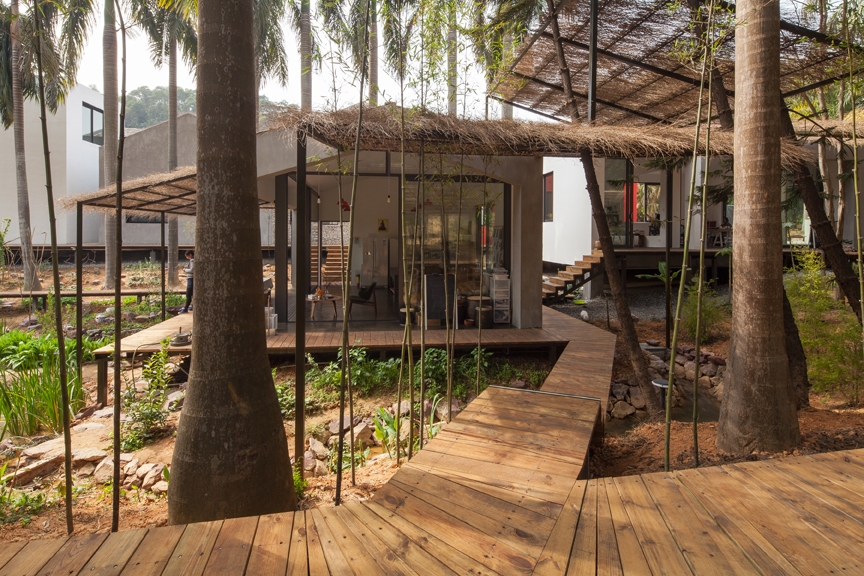Walking through Mirrored Gardens on the periurban fringe of Guangzhou is an exercise in peeling away the layers between oneself and nature. An initiative of Vitamin Creative Space, the gallery and cultural operation (which fuses commercial gallery operations with those of an independent/alternative art space) of husband-and-wife Hu Fang and Zhang Wei, and Japanese architect Sou Fujimoto, Mirrored Gardens quietly opened in late 2014. Together, they have created something that is more than a new gallery; it’s a meditation that weaves together literary and artistic pursuits with an ecological mission.
Zhang and Hu, who represent some of the most interesting names in art to emerge from within Asia (among them Cao Fei, Heman Chong, Ming Wong, Lee Kit, Koki Tanaka, Xu Tan and Jun Yang), as well as Danh Vō and Olafur Eliasson, have had a career that has largely been an urban (and urbane) venture. Mirrored Gardens, its name inspired by a novel written by Hu, writes a new chapter in their practice, which Hu says has been characterised by a longing for something more primitive. Set within Hualong Agriculture Grand View Garden, a half-baked agricultural ‘theme park’ – the kind of destination that only seems to exist in transition economies – Mirrored Gardens comprises a parade of relatively small buildings set around an emerging, productive landscape. At the entrance is an outhouse that casually blurs typological boundaries: is it a shop? The reception? It’s hard to tell. There is a mysteriousness here that immediately invites you in and yet slows you down.
There is a mysteriousness here that immediately invites you in and yet slows you down.
Fujimoto is known for the gentleness of his buildings, best exemplified by his 2013 Serpentine Pavilion, which resembled a floating cloud. Unlike a cloud, however, it had more steel struts than the Eiffel Tower. This is the beauty of Fujimoto’s buildings: on the one hand, seemingly transient; on the other, firmly grounded. This quality is on display too in Mirrored Gardens. The showpiece here is a long series of galleries, arcaded and blocky in form and built around an existing warehouse found on the site, the whole unobtrusively threaded together by a promenade overlooking an agricultural garden. Lofty, airy and muted, the main gallery opened in mid-January with an exhibition by Hong Kong artist Lee Kit. Titled We’ll Never Go Back Again, Kit’s quiet fabrics, gentle canvases and wistful imagery take advantage of the ample natural light. His work was an apt premiere for this kind of place: relax, take off your shoes, Fujimoto and Kit seemed to tell us. The architecture is simple: rustic but refined. The melody of the buildings takes its cue from the vernacular village architecture of angular roofed houses found in the area. In Mirrored Gardens, each ‘house’ has a different finish, one painted bright red, for example, another, inspired by a house in a nearby village, clad in oyster shells sourced from local fishermen and restaurants. When you describe these buildings it seems as if they should irredeemably clash; in reality, they don’t. Furthermore, the buildings sit on a stilted platform, evoking the architecture of Southern Chinese boat people while also having a light footprint on the land. The result is a contemporary architecture that does not look that contemporary.
Zhang and Hu were introduced to Fujimoto by curator Hans Ulrich Obrist in 2008, and they had been looking for a project on which to collaborate since then. So when they hatched the idea for Mirrored Gardens, they invited Fujimoto to come down and have a look. During its three-year creation, beginning in 2011, he visited nearby villages and drew inspiration from the local settlement typologies of continuous and interlocking houses. He modelled up a series of options until he and his client settled on what we have today – a long house set within three pavilions that are scattered around a garden. “As we developed the design, it became more and more rich,” says Fujimoto, “but then it also became more and more simple.”
“It will not become a restaurant,” Zhang promises, “because it should always be a bit ambiguous.”
Adjacent to the gallery is perhaps the most inviting place of all, what Zhang and Hu cheerfully call the kitchen. A roomy, open hearth that looks out onto a generous allotment, it is a place dedicated to cooking and culinary exploration. Teas and herbs are meticulously catalogued, large countertops and tables invite conversation and experimentation, and a videowork by Tanaka ruminates on the meaning of it all. Staff and friends linger, preparing food, drinking tea, chatting and laughing. This is food as media, where we are encouraged to bring our body into the thinking.
“It will not become a restaurant,” Zhang promises, “because it should always be a bit ambiguous.” It is the centrepiece of a nascent but growing farm where rainwater is naturally treated by the land and a fairly sophisticated compost system nourishes the soil. Zhang and Hu have invited local farmers to work here and grow crops. It is self-made and there is no perfection to it, which seems to be the point; to do otherwise would be to create a relationship between art and nature that could only hope to be superficial. What we have instead is a sustainability project as much an artistic one, which in our age of environmental crisis is something we should all be more engaged with. Perhaps Zhang and Hu are telling us to calm down a bit. It’s a slowfood kind of polemic that elevates enjoyment of the simple things in life. “We’ve prepared the ground first,” say Hu, “and now will come the programme.”
This article was first published in the Summer 2015 issue.
